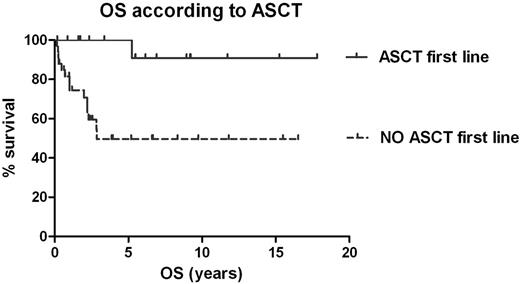Abstract
Introduction: Immunoglobulin light chain amyloidosis (AL) may occur in association with a recognizable plasma cell (PC) clone diagnostic for multiple myeloma (MM) both with CRAB symptoms (AL-CRAB) and without them but with more than 10% marrow PCs (AL-PCMM). Prognosis of AL-CRAB and AL-PCMM was significantly poorer than AL in a large retrospective study by the Mayo Clinic (Kourelis et al, JCO 2013). Treatment with autologous stem cell transplantation (ASCT) improved the 5-y overall survival (OS) rates of all the three entities by approximately 40%. Therefore it is debated if patients with AL should receive more MM-oriented treatment including ASCT and if patients with AL-PCMM or AL-CRAB should receive the same treatment as MM patients.
Aims: to contribute to this debate we analysed the outcome of patients with amyloidosis treated at our center according to their underlying disease: AL, AL-PMCC and AL-CRAB. Furthermore, we analysed the outcome according to the use of ASCT as part of first line treatment strategy.
Methods: Of 53 patients newly diagnosed between Jan 1999 to June 2016 (median age 62 years), 19 (36%) were affected by AL, whereas 23 (43%) presented with AL-PCMM and 11 (21%) with AL-CRAB. Of 53 patients 18 (34%) underwent first line ASCT (21% of AL patients, 35% of AL-PCMM and 55% of AL-CRAB patients), upfront (6) or following induction chemotherapy (12). The 35 patients (66%) who didn't receive ASCT were treated with CyBorD regimen (21), melphalan-dexamethasone (8), VMP (4) or lenalidomide-dexamethasone (2). Risk groups were identified as follows: cTnI >0.1ng/ml and/or ECOG PS ³3: high risk; age ²65 years with normal cTnI levels, ECOG PS <3 and eGFR > 50ml/min: low risk. Intermediate risk patients were defined if not meeting criteria for high or low risk. Mayo Stage classification (Dispenzieri et al, JCO 2004) was also applied to stratify risk categories. MM diagnosis was made according to IMWG criteria. Haematological and organ response (OR), OS and event free survival (EFS: time to 2nd line therapy or death) were analysed.
Results: the proportion of high risk patients was 37%, 44% and 18% in AL, AL-PCMM and AL-CRAB, respectively, whereas the proportion of Mayo stage III patients was 47%, 30% and 9% for each subgroup. Median dFLC was similar (150, 150 and 146, respectively), such as baseline NT-proBNP (1318, 1301 and 1396). No difference was observed in terms of haematologic and organ response between patients with AL only or with concomitant MM: overall response rate (ORR) and complete remission (CR) were 63% and 37% in AL only patients and 88% and 32% if concomitant MM was present, whereas organ response was 47% and 56%, respectively. Similar results were seen among high risk or Mayo Stage III patients between the two subgroups. Haematologic response was similar between patients receiving ASCT in first line treatment and patients who did not: ORR and CR rates were 89% and 44% in the ASCT group and 71% and 29% in the no ASCT group, respectively. However, OR was significantly higher in the ASCT group (83% vs 37%, p 0.0014). Toxicity was manageable in both groups. After a median follow up of 32 months no significant difference was seen overall between AL only and AL with concomitant MM in terms of EFS (65% vs 85% at 2 years, respectively; HR 1,46, 95% CI 0,64-3,35) and OS (71% vs 87% at 2 years, respectively; HR 2,28, 95% CI 0,75-6,95). ASCT significantly improved both EFS and OS, comparing patients receiving or not transplantation (EFS 87% vs 64% at 2 years, p 0,013; HR 0,41, 95% CI 0,21-0,83; OS 100% vs 71% at 2 years, p 0,005; HR 0,23, 95% CI 0,08-0,64, see Figure 1). Of note, in patients achieving OR, similar OS was observed regardless of having received ASCT or not. Our data confirm the survival advantage with ASCT reported by Kourelis et al. The better outcome observed in AL with concomitant MM may be due to the more frequent use of a transplant strategy in first line treatment for AL-MM at our institution.
Conclusion: We confirm that selected patients with AL AL-PCMM and AL-CRAB may have a survival advantage when receiving ASCT. These results may be related to the higher OR rates obtained with ASCT and to the improvement in OS in patients achieving OR. As no difference in terms of treatment response were observed between different underlying diseases, our study also supports the use of conventional MM treatment therapies incorporating high doses of melphalan followed by ASCT also for patients with AL
No relevant conflicts of interest to declare.
Author notes
Asterisk with author names denotes non-ASH members.


